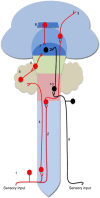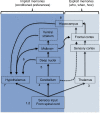The role of orgasm in the development and shaping of partner preferences
- PMID: 27799080
- PMCID: PMC5087697
- DOI: 10.3402/snp.v6.31815
The role of orgasm in the development and shaping of partner preferences
Abstract
Background: The effect of orgasm on the development and shaping of partner preferences may involve a catalysis of the neurochemical mechanisms of bonding. Therefore, understanding such process is relevant for neuroscience and psychology.
Methods: A systematic review was carried out using the terms Orgasm, Sexual Reward, Partner Preference, Pair Bonding, Brain, Learning, Sex, Copulation.
Results: In humans, concentrations of arousing neurotransmitters and potential bonding neurotransmitters increase during orgasm in the cerebrospinal fluid and the bloodstream. Similarly, studies in animals indicate that those neurotransmitters (noradrenaline, oxytocin, prolactin) and others (e.g. dopamine, opioids, serotonin) modulate the appetitive and consummatory phases of sexual behavior and reward. This suggests a link between the experience of orgasm/sexual reward and the neurochemical mechanisms of pair bonding. Orgasm/reward functions as an unconditioned stimulus (UCS). Some areas in the nervous system function as UCS-detection centers, which become activated during orgasm. Partner-related cues function as conditioned stimuli (CS) and are processed in CS-detector centers.
Conclusions: Throughout the article, we discuss how UCS- and CS-detection centers must interact to facilitate memory consolidation and produce recognition and motivation during future social encounters.
Keywords: dopamine; ejaculation; opioids; orgasm; pair bonding; partner preference; sexual reward.
Conflict of interest statement
and funding The authors declare no conflict of interest. The authors have not received any funding or benefits from industry or elsewhere to conduct this study.
Figures


Similar articles
-
Behavioral, Neural, and Molecular Mechanisms of Conditioned Mate Preference: The Role of Opioids and First Experiences of Sexual Reward.Int J Mol Sci. 2022 Aug 10;23(16):8928. doi: 10.3390/ijms23168928. Int J Mol Sci. 2022. PMID: 36012194 Free PMC article. Review.
-
The role of conditioning on heterosexual and homosexual partner preferences in rats.Socioaffect Neurosci Psychol. 2012 Mar 15;2:17340. doi: 10.3402/snp.v2i0.17340. eCollection 2012. Socioaffect Neurosci Psychol. 2012. PMID: 24693350 Free PMC article.
-
Effect of CS preexposure on the conditioned ejaculatory preference of the male rat: behavioral analyses and neural correlates.Learn Mem. 2018 Sep 17;25(10):513-521. doi: 10.1101/lm.048108.118. Print 2018 Oct. Learn Mem. 2018. PMID: 30224554 Free PMC article.
-
Prolactinergic and dopaminergic mechanisms underlying sexual arousal and orgasm in humans.World J Urol. 2005 Jun;23(2):130-8. doi: 10.1007/s00345-004-0496-7. Epub 2005 May 12. World J Urol. 2005. PMID: 15889301 Review.
-
Who, what, where, when (and maybe even why)? How the experience of sexual reward connects sexual desire, preference, and performance.Arch Sex Behav. 2012 Feb;41(1):31-62. doi: 10.1007/s10508-012-9935-5. Arch Sex Behav. 2012. PMID: 22402996 Review.
Cited by
-
Mind-body-spirit model for the medical management of female sexual well-being.Curr Sex Health Rep. 2020 Dec;12(4):389-397. doi: 10.1007/s11930-020-00291-3. Epub 2020 Oct 31. Curr Sex Health Rep. 2020. PMID: 33815006 Free PMC article.
-
Endogenous Opioid Release After Orgasm in Man: A Combined PET/Functional MRI Study.J Nucl Med. 2023 Aug;64(8):1310-1313. doi: 10.2967/jnumed.123.265512. Epub 2023 Jul 13. J Nucl Med. 2023. PMID: 37442599 Free PMC article.
-
Sexual intimacy in couples is associated with longer telomere length.Psychoneuroendocrinology. 2017 Jul;81:46-51. doi: 10.1016/j.psyneuen.2017.03.022. Epub 2017 Mar 25. Psychoneuroendocrinology. 2017. PMID: 28411413 Free PMC article.
-
Introductory editorial to 'Orgasm: Neurophysiological, Psychological, and Evolutionary Perspectives'.Socioaffect Neurosci Psychol. 2016 Oct 25;6:33598. doi: 10.3402/snp.v6.33598. eCollection 2016. Socioaffect Neurosci Psychol. 2016. PMID: 27791969 Free PMC article. No abstract available.
-
Mating and social exposure induces an opioid-dependent conditioned place preference in male but not in female prairie voles (Microtus ochrogaster).Horm Behav. 2018 Jan;97:47-55. doi: 10.1016/j.yhbeh.2017.10.015. Epub 2017 Nov 8. Horm Behav. 2018. PMID: 29111331 Free PMC article.
References
-
- Adler N. T. Effects of the male's copulatory behavior on successful pregnancy of the female rat. Journal of Comparative Physiological Psychology. 1969;69(4):613–622. - PubMed
-
- Agmo A, Berenfeld R. Reinforcing properties of ejaculation in the male rat: Role of opioids and dopamine. Behavioral Neuroscience. 1990;104(1):177–182. - PubMed
-
- Aragona B. J, Liu Y, Yu Y. J, Curtis J. T, Detwiler J. M, Insel T. R, et al. Nucleus accumbens dopamine differentially mediates the formation and maintenance of monogamous pair bonds. Nature Neuroscience. 2006;9(1):133–139. doi: http://dx.doi.org/10.1038/nn1613. - DOI - PubMed
-
- Barnett S. A. The rat: A study in behaviour. Chicago, IL: Aldine; 1963.
LinkOut - more resources
Full Text Sources
Other Literature Sources
